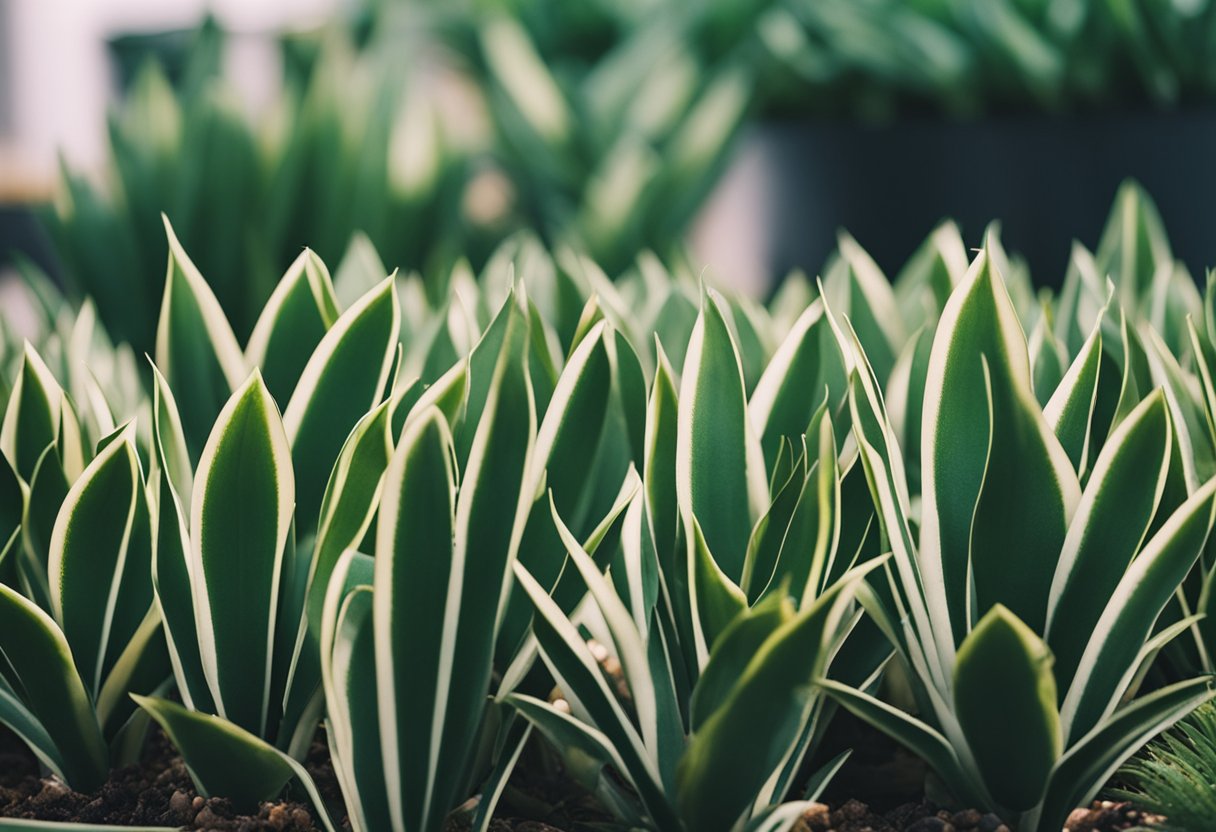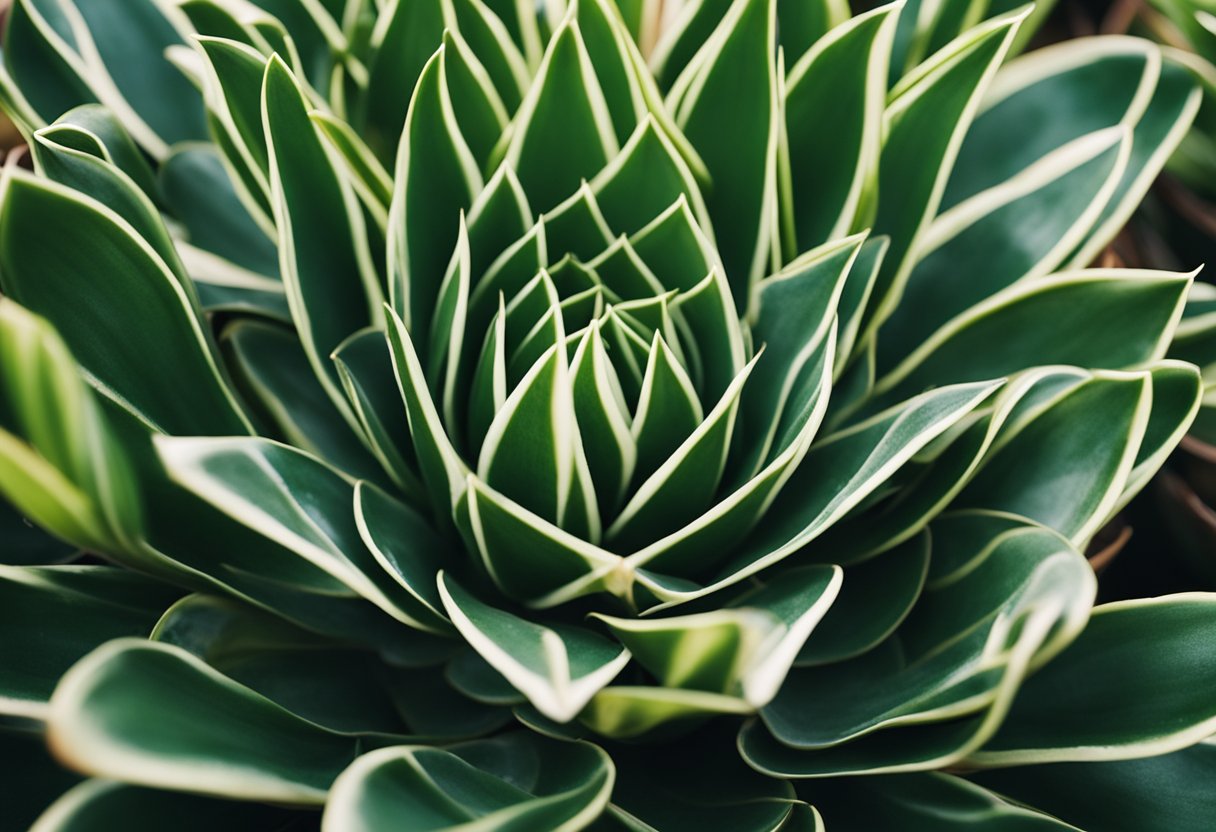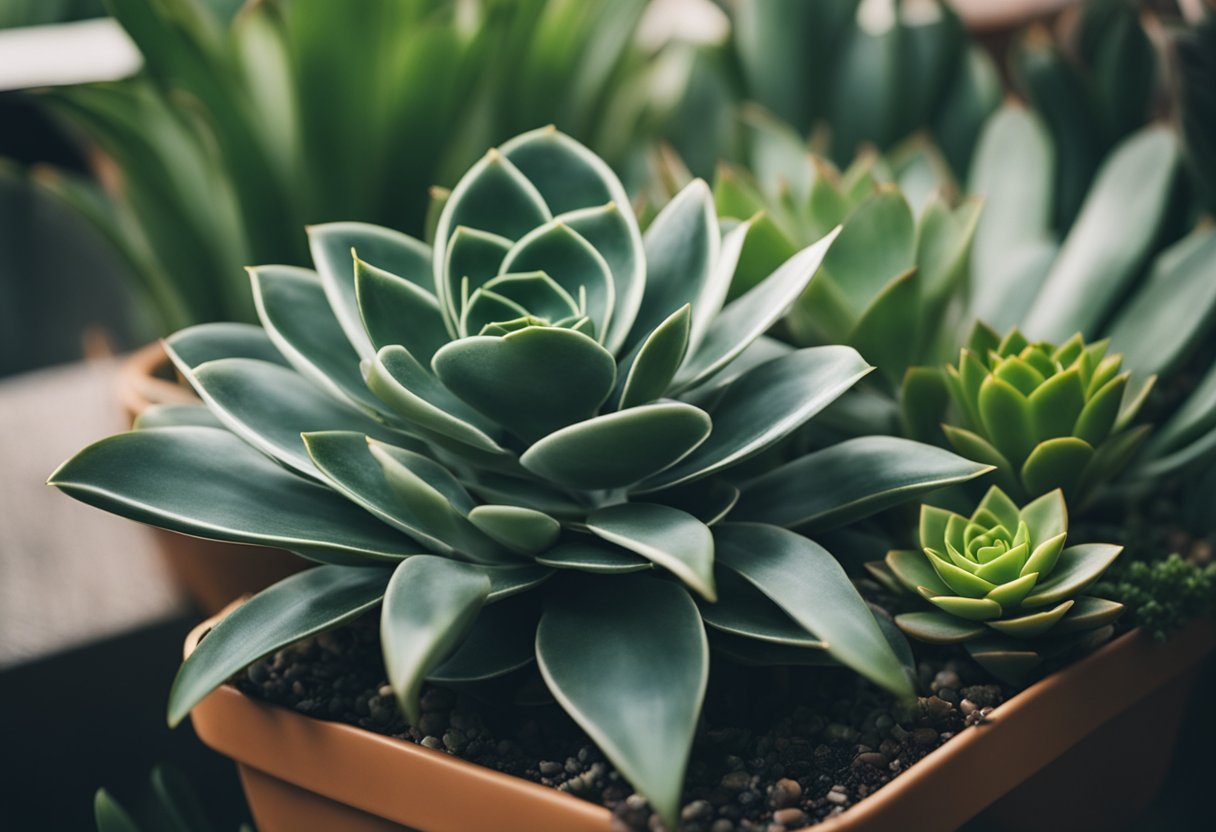Are Snake Plants Succulents? A Clear Answer
Snake plants are a popular houseplant due to their easy care and attractive appearance. However, there is some confusion surrounding whether or not snake plants are considered succulents. Some sources claim that snake plants are succulents, while others argue that they are not. So, are snake plants succulents?
This post may contain affiliate links, which means I’ll receive a commission if you purchase through my link, at no extra cost to you. Please read full disclosure here.

Succulents are plants that have adapted to survive in arid environments by storing water in their leaves, stems, or roots. They are known for their fleshy, thick leaves and ability to survive in dry conditions. Snake plants, also known as Sansevieria, have similar characteristics to succulents, such as shallow roots and the ability to store water in their leaves. These features allow snake plants to survive in low light and low humidity environments, making them a popular choice for indoor plants. However, not all snake plant species are considered succulents, and there is some debate among experts over whether or not they should be classified as such.
What Are Snake Plants

Snake plants, also known as Sansevieria or Dracaena trifasciata, are a type of succulent that originated from West Africa. They are popular as houseplants due to their ease of care and resilience. Snake plants come in different varieties, each with unique characteristics and features.
One of the most common snake plant species is the Sansevieria trifasciata, also known as the mother-in-law’s tongue. This species has long, upright leaves that are stiff and sword-like, with green-banded or striped leaves that have a yellow or cream border. Another popular species is the Sansevieria cylindrica, also known as the cylindrical snake plant, which has long, cylindrical leaves that grow in a fan shape.
Other snake plant species include the Sansevieria laurentii, also known as the golden flame, which has yellow margins on its leaves, and the Sansevieria moonshine, which has silvery-green leaves. The Sansevieria whale fin, also known as the snake plant whale fin, has long, narrow leaves that are shaped like a whale’s fin.
Snake plants are members of the genus Sansevieria, which is a part of the family Asparagaceae. However, recent genetic research has led to the reclassification of snake plants into the genus Dracaena.
Overall, snake plants are known for their ability to thrive in a variety of conditions, including low light and dry air. They are also known for their air-purifying properties, making them a popular choice for indoor spaces.
Snake Plants and Succulents

Snake plants are often classified as succulents due to their fleshy leaves that are capable of storing water. However, not all snake plants are considered succulents. The Sansevieria genus, which includes snake plants, is a part of the Asparagaceae family, which is different from the Cactaceae family that includes cacti.
Succulents are plants that have adapted to survive in arid environments by storing water in their leaves, stems, or roots. They are known for their thick, fleshy leaves and ability to withstand long periods of drought. Cacti, on the other hand, are a type of succulent that are characterized by their unique, spiny appearance.
While snake plants share some similarities with succulents, they also have distinct differences. For example, unlike most succulents, snake plants do not have a thick waxy coating on their leaves to prevent water loss. Instead, they have adapted their stomata to minimize water loss.
Another difference between snake plants and succulents is their growth habit. Most succulents, including cacti, have a compact, round growth habit. Snake plants, on the other hand, have a more upright growth habit, with long, sword-shaped leaves that can grow up to several feet tall.
In conclusion, while snake plants share some characteristics with succulents, they are not technically considered succulent plants. They are a unique type of plant that belongs to the Asparagaceae family and have adapted to survive in dry environments in their own unique way.
Growing Conditions for Snake Plants
Snake plants are known for their hardiness and ability to tolerate a range of growing conditions, making them a great choice for beginners. They are native to both Asia and Africa, and can be grown both indoors and outdoors.
Light
Snake plants prefer bright, indirect light but can also tolerate low light conditions. Direct sunlight can scorch their leaves, so it’s best to keep them in a spot that receives filtered or indirect sunlight. Outdoors, they can be grown in partial shade or full sun depending on the climate.
Temperature and Humidity
Snake plants thrive in temperatures between 60°F and 85°F (15°C to 29°C). They can tolerate lower temperatures but may suffer damage if exposed to frost. They also prefer low to moderate humidity levels.
Soil and Watering
Snake plants prefer well-draining soil and do not like to be overwatered. Allow the top inch of soil to dry out before watering, and avoid getting water on the leaves as this can lead to rot.
Fertilizing
Snake plants do not require frequent fertilization. A balanced, all-purpose fertilizer can be applied once a month during the growing season (spring and summer).
Overall, snake plants are low-maintenance and can thrive in a variety of growing conditions. With proper care, they can live for many years.
Watering and Soil Needs
Snake plants are drought-tolerant, which means they can survive long periods without water. Overwatering is one of the most common mistakes people make when caring for snake plants. It can lead to water storage in the soil, which can cause root rot and kill the plant. Therefore, it is important to water snake plants only when their soil is completely dry.
To check if a snake plant needs water, one can poke a finger two or three inches deep into the soil. If it feels dry, it’s time to water the plant. It is important to note that the watering frequency depends on various factors such as temperature, sunlight levels, local humidity, container volume, soil quality, and the size and age of the plant.
Snake plants prefer well-draining soil that allows excess water to drain out of the pot. It is recommended to use a pot with drainage holes to prevent water from accumulating in the soil. If the soil is not well-draining, it can cause water storage, which can lead to root rot.
When repotting a snake plant, it is important to use well-draining soil. One can make a well-draining soil mix by combining potting soil, sand, and perlite in a 2:1:1 ratio. The sand and perlite help to increase the drainage of the soil.
In summary, snake plants are succulent-like plants that require well-draining soil and infrequent watering. Overwatering and water storage in the soil can cause root rot, which can kill the plant. It is important to use a pot with drainage holes and check the soil’s moisture level before watering the plant.
Snake Plant Propagation
Snake plants are popular houseplants due to their low-maintenance nature and air-purifying abilities. Propagating snake plants is relatively easy and can be done through division or stem cuttings.
Division
Dividing a mature snake plant with multiple stems is the most common method of propagation. To do this, remove the entire plant from its pot and gently separate the stems. Ensure that each stem has an adequate root system and replant them in separate pots with well-draining soil.
Stem Cuttings
Stem cuttings can also be used to propagate snake plants. Cut a leaf near the base of the plant and allow the cut end to dry for a few hours. Then, place the cutting in water or well-draining soil and keep it in a warm, bright location. When the cutting has developed roots, transplant it into a separate pot.
Pups
Snake plants also produce pups or plantlets, which are small, genetically identical plants that grow from the same root system. These can be cleaved away from the parent plant once they have developed a root system and replanted in separate pots.
Propagation of snake plants should be done during the growing season, which is typically in the spring or summer. It is important to use well-draining soil and avoid overwatering, as snake plants are succulents and can be susceptible to root rot. Divisions and stem cuttings should be allowed to dry before planting to prevent rot.
Overall, snake plant propagation is a straightforward process that can be done with a little bit of patience and care.
Plant Care and Maintenance
Snake plants are low maintenance and easy to care for, making them a great choice for beginner plant parents. They are succulent plants, which means they store water in their leaves, making them drought-tolerant. Here are some tips for taking care of your snake plant:
Grow
Snake plants can grow up to 4 feet tall, but they usually stay around 2-3 feet. They prefer bright, indirect light, but can also tolerate low light conditions. They are also tolerant of a wide range of temperatures, but prefer warm temperatures between 70-90°F.
Leaves
The leaves of a snake plant are stiff and sword-like, and can be green-banded or striped with a yellow or cream border. They are also known for their air-purifying properties, making them a great addition to any home or office.
Roots
Snake plants have shallow roots and prefer well-draining soil. They do not require frequent watering, and it is important to let the soil dry out completely between waterings to prevent root rot.
Height
Snake plants can be grown in pots of various sizes, and their height can be controlled by the size of the pot. They can also be propagated by dividing the rhizomes and repotting them in separate containers.
Fertilize
Snake plants do not require frequent fertilization, but can benefit from a balanced fertilizer once or twice a year during the growing season.
Pruning and Trimming
Snake plants do not require frequent pruning or trimming, but can be trimmed to remove any dead or damaged leaves.
Repotting
Snake plants do not require frequent repotting, and can be repotted every 2-3 years or when they become root-bound. It is important to use well-draining soil and a pot with drainage holes to prevent root rot.
Overall, snake plants are a great choice for anyone looking for a low maintenance and easy to care for plant. With proper care, they can thrive and add a touch of greenery to any space.
Snake Plant Varieties
Snake plants, also known as Sansevieria, are a popular houseplant due to their low maintenance and air-purifying qualities. There are many different varieties of snake plants, each with their own unique characteristics.
One popular variety is the Twisted Sister, which features twisted leaves with a bright green center and yellow margins. This variety is a great choice for adding a pop of color to any room.
Another popular variety is the Golden Hahnii, which has shorter, wider leaves with a golden yellow center and dark green margins. This variety is great for smaller spaces and adds a touch of warmth to any room.
The Black Gold snake plant is another popular variety, featuring dark green leaves with golden yellow edges. This variety is known for its striking appearance and is sure to make a statement in any room.
Other popular snake plant varieties include the Futura Robusta, Laurentii, and Moonshine. Each variety has its own unique characteristics, making it easy to find the perfect snake plant for any space.
Overall, snake plants are a great choice for anyone looking for a low maintenance houseplant with air-purifying qualities. With so many different varieties to choose from, there is sure to be a snake plant that fits any style and space.
Snake Plants as Indoor Plants
Snake plants are a popular choice for indoor plants due to their unique appearance and ease of care. They are native to Western Africa and are also known as “Mother-in-Law’s Tongue” and Sansevieria. Snake plants are considered succulents because they store water in their leaves and are adapted to dry environments.
One of the benefits of snake plants is that they are air purifiers. They help to filter indoor air, even at night, making them a great addition to any home. They are also low-light plants, meaning they can thrive in areas with minimal natural light. This makes them a perfect choice for those who want to add greenery to their home but do not have a lot of natural light.
Snake plants can also be used as companion plants. They can be planted with other indoor plants such as ivy and fittonia to create a visually appealing display. Snake plants are also great for those who are new to indoor gardening, as they are very forgiving and require minimal care.
Overall, snake plants are a great choice for anyone looking to add some greenery to their home without the hassle of high maintenance plants. They are easy to care for, air purifiers, and can thrive in low-light environments.
Health Benefits and Risks of Snake Plants
Snake plants are known for their air-purifying abilities, making them a popular choice for indoor plants. They are particularly effective at removing formaldehyde and benzene from the air, which are commonly found in household items such as cleaning products and furniture. Snake plants also produce oxygen at night, making them a great addition to bedrooms.
In addition to their air-purifying abilities, snake plants have been shown to have mental health benefits. Studies have found that having plants in the home can help reduce stress and anxiety, and snake plants are no exception. They are also easy to care for, making them a great choice for those who are new to plant care.
However, it’s important to note that snake plants are mildly toxic to pets and humans. They contain saponins, which can cause diarrhea and other digestive issues if ingested. It’s important to keep snake plants out of reach of children and pets, and to wash your hands after handling them.
Overall, snake plants are a great choice for those looking to improve the air quality in their homes and reduce stress and anxiety. However, it’s important to be aware of their potential risks and to take precautions to keep them out of reach of children and pets.
Potential Issues with Snake Plants
Snake plants are generally easy to care for and are known for being hardy plants. However, like any plant, they can experience issues that can impact their health and appearance. Here are some potential issues to keep in mind when caring for your snake plant:
Pests
While snake plants are relatively pest-resistant, they can still fall victim to common houseplant pests like spider mites and mealybugs. These pests can cause damage to the leaves and can even spread to other plants in your collection. To prevent an infestation, regularly inspect your snake plant for signs of pests and take action immediately if you spot any.
Diseases
Snake plants can also be susceptible to fungal and bacterial diseases. Overwatering can lead to root rot, which can cause the plant’s leaves to turn yellow and become soft and mushy. To prevent root rot, make sure your snake plant is planted in well-draining soil and avoid overwatering. If you notice any signs of disease, remove the affected leaves and adjust your watering schedule as needed.
Shock
Snake plants can experience shock if they are moved to a new location or if their environment changes suddenly. This can cause the leaves to droop or become discolored. To prevent shock, gradually acclimate your snake plant to its new environment by slowly exposing it to the new conditions over a period of several days.
Drafts
Snake plants are sensitive to cold drafts and can suffer if they are placed in a drafty location. This can cause the leaves to become discolored or even fall off. To prevent damage from drafts, make sure your snake plant is placed in a location with consistent temperatures and minimal air flow.
Shady Conditions
While snake plants can tolerate low light conditions, they still need some sunlight to thrive. If your snake plant is not receiving enough light, it can become leggy and the leaves may turn yellow. To prevent this, make sure your snake plant is placed in a location with bright, indirect sunlight.
Poisonous
One thing to keep in mind when caring for a snake plant is that it is toxic to pets and humans if ingested. Make sure to keep your snake plant out of reach of children and pets, and wash your hands thoroughly after handling the plant. If you suspect that your pet has ingested any part of the snake plant, contact your veterinarian immediately.